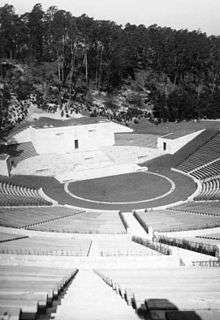Thrust stage
In theatre, a thrust stage (also known as a platform stage or open stage)[1] is one that extends into the audience on three sides and is connected to the backstage area by its upstage end. A thrust has the benefit of greater intimacy between performers and the audience than a proscenium, while retaining the utility of a backstage area. Entrances onto a thrust are most readily made from backstage, although some theatres provide for performers to enter through the audience using vomitory entrances. A theatre in the round, exposed on all sides to the audience, is without a backstage and relies entirely on entrances in the auditorium or from under the stage.
As with an arena, the audience in a thrust stage theatre may view the stage from three or more sides. Because the audience can view the performance from a variety of perspectives, it is usual for the blocking, props and scenery to receive thorough consideration to ensure that no perspective is blocked from view. A high backed chair, for instance, when placed stage right, could create a blind spot in the stage left action.
History
The thrust stage is the earliest stage type in western theatre, first appearing in Greek theatres, and its arrangement was continued by the pageant wagon. As pageant wagons evolved into Elizabethan theatre, many of that era's works, including those of Shakespeare, were performed on theatre with an open thrust stage, such as those of the Globe Theatre.
The thrust stage concept was generally out of use for centuries, and was resurrected in 1953 by the Stratford Shakespeare Festival of Canada.[2] Their Festival Theatre was originally under a tent, until a permanent thrust stage theatre facility was constructed in 1957. Since that time dozens of other thrust stage venues have been built using the concept.
Thrust stage theatres
North America
Canada
- The Maclab Theatre at the Citadel Theatre in Edmonton, Alberta
- The Festival Theatre at the Atlantic Theatre Festival in Wolfville, Nova Scotia
- The Festival Theatre at the Stratford Shakespeare Festival in Stratford, Ontario
- The Studio-théâtre at Place des Arts, Montreal, Quebec
- The UFV Theatre at the University of the Fraser Valley in Chilliwack, British Columbia
- The BMO Mainstage at Bard on the Beach in Vancouver, British Columbia
United States
- The ANTA Washington Square Theatre in Greenwich Village, New York (now demolished)
- The Octagon Stage at the Alabama Shakespeare Festival in Montgomery, Alabama
- The Mark Taper Forum in Los Angeles
- The Berkeley Repertory Theatre in Berkeley, CA
- The PCPA Marian Theatre in Santa Maria, CA
- The PCPA Solvang Festival Theatre in Solvang, CA
- The John W. Huntington Theatre at Hartford Stage in Hartford, Connecticut
- The La Nouba stage in Downtown Disney in Florida
- The Alhambra Dinner Theatre in Jacksonville, Florida
- The Gateway Theatre in Chicago
- The Chicago Shakespeare Theatre in Chicago
- The Ethel M. Barber Theater at Northwestern University in Evanston, Illinois
- The Guthrie Theater in Minneapolis
- The Greenbelt Arts Center in Greenbelt, Maryland
- The Court Street Theatre in Nashua, New Hampshire
- The Seacoast Repertory Theatre in Portsmouth, New Hampshire
- The Crossroads Theater in New Brunswick, New Jersey
- The George Street Playhouse in New Brunswick, New Jersey
- The Circle in the Square Theatre, New York City
- The Vivian Beaumont Theater at Lincoln Center, New York
- The Mystère theater in the Treasure Island hotel in Paradise, Nevada
- The Carolina Actors Studio Theatre in Charlotte, North Carolina
- The Paul Green Theatre at PlayMakers Repertory Company in Chapel Hill, North Carolina
- The O'Reilly Theater in Pittsburgh, Pennsylvania
- The Kleberg Stage at the Zach Theatre in Austin, Texas
- The Blackfriars Playhouse at the American Shakespeare Center in Staunton, Virginia
- The Playhouse at the Overture Center for the Arts in Madison, Wisconsin
- The American Players Theatre in Spring Green, Wisconsin
- The Todd Wehr Theater at the Marcus Center for the Performing Arts in Milwaukee, Wisconsin
- The Barksdale Theatre at the Shops at Willow Lawn in Richmond, Virginia
- The Lowell Davies Festival Theatre at the Old Globe in San Diego, California
- Centre Stage-South Carolina in Greenville, South Carolina
- Theatre Suburbia in Houston, Texas
- Playcrafters Barn Theatre in Moline, Illinois [3]
Europe

Germany
- Waldbühne ("Forest Stage"), Berlin
Greece
- Numerous Greek theatres, such as the one in Epidaurus
United Kingdom
- The Questors Theatre, Ealing
- The Crucible Theatre in Sheffield, England
- The Gulbenkian Theatre in Canterbury, England
- The Globe Theatre in London, England. All other Elizabethan Theatres were also in the same style.
- The Olivier Theatre in the National Theatre, London
- The Everyman Theatre in Liverpool, England
- The Chichester Festival Theatre. Notable for the fact that the stage is hexagonal, and is surrounded by the audience on four sides.
- The Swan Theatre in Stratford-upon-Avon, England
- The Courtyard Theatre in Stratford-upon-Avon, England
- Elmbank Studios, Ayr
- The Quarry Theatre at the West Yorkshire Playhouse, Leeds
- The Riverside Theatre in Coleraine, Northern Ireland
Asia
India
- Prithvi Theatre, Mumbai
- Ranga Shankara, Bangalore
- Jagriti Theatre, Bangalore
- Bhartendu Natya Academy, Lucknow, Uttar Pradesh
Oceania
Australia
- The York Theatre, part of the Seymour Centre, Sydney
- George Jenkins Theatre in Frankston, Victoria
References
External links
- "RSC Transformation: The thrust stage". Archived from the original on August 9, 2013.
- "Stage Types - Thrust". Theatre Design.
- Mystère theatre diagram Diagram of Cirque du Soleil's Mystère theatre
- Thrust stage diagram